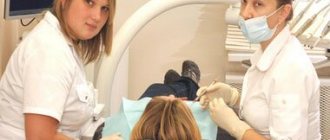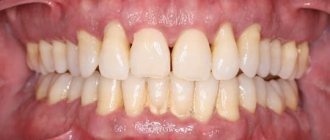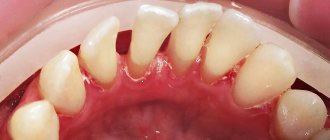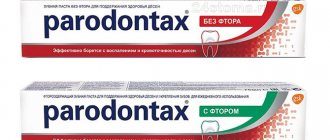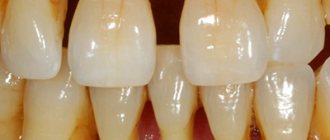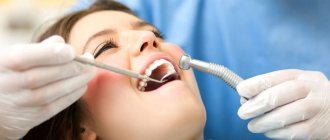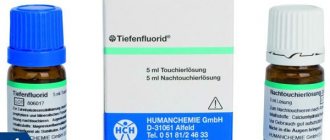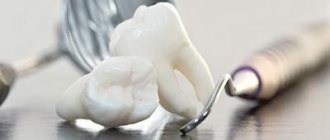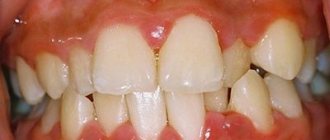Periodontal disease: features of the disease
Periodontal disease is an oral disease that affects the gums. Due to the narrowing of the blood vessels located in the soft tissues of the oral cavity, the supply of nutrients to the gums is reduced.
This leads to degeneration of the tissues around the teeth.
Periodontal disease is a rare disease. People who consult a specialist for problems with their gums are usually diagnosed with generalized periodontitis. That is, a disease that has already begun to destroy the periodontium.
With periodontitis, the gums become inflamed, they begin to bleed, and bad breath appears. In the early stages of periodontal disease, such symptoms are not observed. The mucosal tissues look healthy. Which makes diagnosing the problem difficult.
Periodontal disease. Causes, symptoms, treatment, prevention.
Any disease of the teeth and oral cavity should be treated in a timely manner, preventive measures and regular hygienic procedures at the dentist should be carried out.
Among the wide range of diseases of teeth and gums, one should highlight a disease such as periodontal disease . It differs from other diseases in that it is the last stage of inflammatory gum disease, which is accompanied and aggravated by internal diseases of the body. Periodontal disease occurs in 5-10% of cases. It is often accompanied by diseases such as diabetes mellitus and other diseases of the internal secretion organs (hormonal disorders), atherosclerosis, when, due to damage to the walls of blood vessels, blood circulation is impaired, which leads to insufficient nutrition of the gums, gastrointestinal diseases, hypovitaminosis, decreased immunity, etc.
To clearly understand what periodontal disease is and how it differs from periodontitis, let’s first understand the terminology. The fact is that patients often make a mistake and write “periodontal disease” instead of the correct “periodontal disease”, but they also confuse two completely different diseases “periodontal disease” and “periodontitis”.
Periodontal disease is a disease that affects the tissues surrounding the tooth. These tissues are called periodontium.
Symptoms of periodontal disease
Periodontal disease, the symptoms of which differ from the symptoms of periodontitis, is expressed by such sensations as itching of the gums, exposure of the necks of the teeth, as a result of which there is a pronounced sensitivity to cold and hot, and significant deposition of tartar. With periodontitis, the patient does not feel pain, as a result of which he postpones visiting the dentist, which ultimately leads to a worsening of the condition and transition to the next stage - periodontal disease. Gums with periodontal disease are light in color, without signs of inflammation. The teeth retain good fixation for a long time. Depending on the form of the disease, the listed symptoms may or may not appear. A pronounced symptom of periodontal disease is the exposure of the necks and roots of the teeth. To get a clearer picture of this disease, pay attention to what periodontal disease looks like in the photo, which presents a terrifying picture. However, patients find it difficult to recognize the presence of the disease and are in no hurry to consult a dentist for help. The first signal to contact a dentist should be the presence of bleeding gums, when when biting off hard food traces of blood remain on it. Redness of the gums and pain should also be a reason to visit a doctor. Since the symptoms of periodontal disease are vague, many people neglect the advice of timely visit to the dentist.
For patients from other regions, our clinic offers such a popular service as dental tourism. You can carry out complex treatment, prosthetics, dental implantation and other procedures, and save a lot of money! We provide: preferential accommodation and assistance in organizing leisure activities. For a free preliminary remote treatment plan and cost estimate, contact us in any way convenient for you: by email, by phone or via widget (send a request or request a free call back).
In fact, this disease is quite serious and requires immediate treatment, since a positive result can only be achieved at an early stage. The fact is that periodontal disease affects the bone tissue of the jaws and gum tissue, which are very difficult to restore. If periodontal disease is not treated, you can lose teeth at an early age.
Symptoms of periodontitis
Periodontitis is a common inflammatory disease that, according to WHO, affects up to 80% of the world's population. Its symptoms are severe inflammation of the gums with purulent discharge, tooth mobility, and painful sensations. The pronounced symptoms of periodontitis force you to consult a doctor more often, in contrast to periodontal disease, when seeking help from a specialist is usually too late.
Periodontitis is an inflammatory disease that has several similar symptoms to periodontal disease when it reaches advanced stages. To organize effective treatment, it is necessary to clearly understand the difference between these diseases.
Both diseases require immediate and professional treatment.
Let us immediately note that treating periodontal disease at home is impossible. The only thing that can be done at home as an accompanying measure for the main treatment is hygiene procedures, oral care (brushing teeth using dental floss), eating solid food (fruits, vegetables), which provides the necessary load on the masticatory apparatus and compensates for lack of vitamins in the body, which is important for maintaining overall health. Treatment of periodontal disease is a serious process that requires medication and sometimes surgical treatment from a periodontist. It is necessary to understand that in case of periodontal disease it is impossible to do without qualified medical help, and a neglected condition can lead to the loss of healthy teeth. At home, treatment is possible only at the initial stage (gingivitis), following the doctor’s recommendations regarding oral care, rinsing with infusions of herbs that have an anti-inflammatory effect.
Diagnosis of periodontal disease
Before starting treatment, you should find out how to diagnose periodontal disease, and then answer the question: how to treat periodontal disease?
Before starting treatment for periodontal disease, it is necessary to establish an accurate diagnosis, which is made by the doctor on the basis of an x-ray examination; it gives a picture of bone tissue damage, which will be evidence of the presence of the disease.
To begin with, at the first manifestations of the disease, and this is in the case of periodontal disease, shrinkage of the gums and their thinning, exposure of the neck of the teeth, sensitivity to hot and cold, bleeding from the gums, you should immediately contact a dental clinic in Perm.
The first action that an experienced doctor will take will be a detailed history taking. And patients should not be surprised when the doctor asks in detail about what diseases you suffer from, which of them your closest relatives suffered from, how you eat, and what mode of work you work in. The answers to all these questions will help the doctor identify the causes and factors that contribute to the worsening of the disease, as well as select the optimal treatment program, with the involvement of doctors of other specialties to carry out complex treatment. One of the actions that a periodontist performs to establish a diagnosis is probing periodontal pockets and determining their depth. An X-ray examination will help confirm the preliminary diagnosis, which will reveal the structure of the bone tissues of the teeth and jaw. If a finely porous bone structure is detected, then periodontal disease is present. When a diagnosis is made and concomitant diseases are identified, the doctor determines how to treat periodontal disease in this particular case.
This will be followed by the development of a treatment strategy, which is selected individually. It should be noted that treatment will require an integrated approach and the involvement of general practitioners, endocrinologists, cardiologists, gastroenterologists in the process, depending on the presence of certain internal diseases.
Treatment of periodontal disease at the dentist
Since periodontal disease is somewhat different from other diseases of the teeth and gums, its treatment requires special qualifications. As in any other field of medicine, where each specialist treats a certain range of diseases, in Perm dentistry, a periodontist treats gums.
Treatment of periodontal disease is accompanied by treatment from other specialists, whose goal is to get rid of internal diseases that aggravate periodontal disease.
That is why this disease is usually considered separately from other dental diseases, since periodontal disease, the treatment of which requires not only the intervention of a periodontist, but also specialized specialists. It requires a general examination of the patient’s condition, identification of primary diseases, as well as comprehensive treatment of internal diseases that affect the course of periodontal disease.
Periodontal disease, the causes of which science has not yet been able to accurately determine, manifests itself against the background of internal diseases that require medical intervention. The cause of periodontal disease, which almost always contributes to its development, is insufficient oral hygiene, an advanced state of inflammatory gum diseases, such as gingivitis and periodontitis. Concomitant causes include weak immunity, endocrine diseases, diseases of the stomach, and vascular system, which aggravate the patient’s condition.
Modern methods of treating periodontal disease involve removing tartar, which in some cases requires surgery. In addition to the main treatment, concomitant diseases should be diagnosed and treated. To draw up a treatment regimen that requires an individual approach, the doctor prescribes tests for microflora and fungus in the oral cavity and, if the result is positive, treatment is carried out aimed at eliminating them.
The main treatment for periodontal disease is that medicinal ointments are placed in the periodontal pockets, which relieve inflammation and bone-forming materials, which prevents further destruction of bone tissue. With periodontal disease, periodontal pockets are formed in the gums, in which microbes accumulate, food debris that gets into the periodontal pockets, they are a breeding ground for these bacteria, therefore one of the areas of treatment for periodontal disease is deep cleaning of periodontal pockets. To do this, you often have to use a surgical method called curettage. It is carried out with a special instrument called a curette, with the help of which tartar is removed from the periodontal pockets, deposited deep in the gums on the neck of the tooth and penetrating deep into the roots of the teeth.
Treatment of periodontal disease includes the use of physiotherapy methods, treatment with a device called an ultrasonic scaler is especially effective. Also effective in the treatment of periodontal disease will be the use of the Darsenval apparatus, vacuum massage of the gums, hydromassage and other physiotherapeutic procedures accompanying the main treatment. Any of these procedures should only be prescribed by a periodontist, as they all have their own contraindications.
Next, it is necessary to take into account that along with the treatment of internal diseases, you will have to pay attention to the general condition of the body, taking vitamins will improve immunity, and a proper balanced diet will restore strength and improve the general condition of the patient.
In some cases, dental prosthetics will be required, which will allow the installation of crowns on damaged teeth, dentures, which will increase the fixation of disease-prone teeth.
And finally, the treatment is surgical, which involves removing tartar at a deep level. This procedure is also called deep curettage. This is done with a curette or sometimes with an operation that involves making an incision in the gum and removing the stone from underneath it. Surgery will also allow for restorative measures such as grafting and bone grafting, if necessary.
The main causes leading to periodontal disease
At the moment, experts have made serious breakthroughs in the study of this disease. But scientists still cannot say that they have studied periodontal disease 100%. At the moment, it is believed that the main reason for the development of this disease is heredity. If at least one of the patient’s parents had this problem, then most likely it will be passed on to the child.
The immediate cause of the development of periodontal disease is a violation of metabolic processes. Disruptions in the body associated with changes in hormonal levels often lead to a decrease in the flow of beneficial substances to the gums. Other reasons worth noting:
- Disease of the gastrointestinal tract.
- Poor nutrition and poor diet.
- Diseases of a neurological nature.
- Alcohol and tobacco abuse.
- Decreased protective functions of the body.
Indirectly, the development of periodontal disease is affected by bite pathologies and mechanical trauma to the periodontium. The formation of plaque and tartar often triggers the onset of processes that will subsequently lead to periodontal disease.
Periodontal disease is...
According to the terminology of the Great Medical Encyclopedia, periodontal disease is a lesion of the periodontium of a dystrophic nature (periodontium is a complex of tissues surrounding the tooth and holding it in the alveolus, having a common origin and function).
Periodontal dystrophy is premature atrophy of the dental alveoli, characterized by progressive resorption of their bone tissue, leading to the formation of pathological periodontal pockets, suppuration from them, loosening of teeth and, often, the occurrence of alveolar abscesses. Let's bring some clarity to medical terminology. Dystrophy is the basis of the process, a violation of the complex of mechanisms (trophism) that ensure the metabolism (metabolic processes) of cells and intercellular substances and the preservation of their structure, as a result of which the function of the organ changes.
Bone resorption - in pathology - resorption of necrotic masses and reabsorption (absorption) of substances into blood or lymphatic vessels.
Alveolar abscess - formed on the alveolar process of the jaw as a result of apical purulent inflammation of the root periosteum of the tooth. The pus, which initially accumulates at the apex of the root, infects the cell and causes inflammation of the bone marrow of its walls.
Classification of periodontal disease
The disease is divided according to the nature of treatment and the area affected. Periodontal disease can be acute or chronic. Since periodontal disease does not cause pain, this disease is called acute. This form of periodontal disease is extremely rare, but can lead to tooth loss in just a couple of years.
Depending on the affected area, periodontal disease can be:
- Localized. Damage to the gums occurs in a small part of the oral cavity. It affects the area of one to several teeth.
- Generalized. The disease affects the entire upper or lower dentition. In rare cases, the patient experiences periodontal disease in both jaws.
Treatment of periodontal disease.
A prerequisite for an integrated approach to the treatment of periodontal disease is the elimination of atherosclerotic changes in blood vessels. To activate blood circulation and lymph flow in the gum tissue, dentists prescribe drug therapy and massage (hardware too), hydromassage, darsonvalization, electrophoresis with vitamins. In addition, electrophoresis and physiotherapeutic procedures (galvanization and ultrasound) are used. Based on the symptoms, treatment methods (the degree of intervention in the process of preventing the development) of periodontal disease are determined. First of all, if periodontal disease is suspected, an X-ray examination is performed. If necessary, the oral cavity is sanitized: carious cavities are filled; remove teeth that cannot be treated; depulpate (remove nervous tissue, clean and fill the canal) those teeth whose bone tissue destruction has reached half the length of the tooth root. Next, dental deposits and plaque are removed either by mechanical means (teeth brushing and curettage of gum pockets), or by sandblasting, or by ultrasound. Antiseptic medications are applied to the cleaned surface of the teeth. Only after this further treatment is carried out. This may include splinting (strengthening mobile teeth) and surgical treatment. Teeth are splinted in three ways. Using fiberglass, using metal-ceramic or all-ceramic crowns welded together, or using a clasp prosthesis. The purpose of splinting is to stabilize mobile teeth. Next is a surgical intervention, the result of which is the elimination of periodontal pockets, the removal of all deposits that have appeared in them and the connective tissue that has formed in place of the destroyed bone.
Symptoms and stages of the disease
Symptoms of periodontal disease depend on the stage of the disease:
- Initial stage. At this stage, even an x-ray cannot reveal processes that negatively affect the tissues of the oral cavity.
- First stage. The gums recede. An experienced dentist can immediately identify the problem. The patient at this stage of the disease notices an increase in tooth sensitivity. The first changes can already be seen on the x-ray.
- Second stage. The neck of the tooth is exposed, and the patient often experiences discomfort when eating cold or hot foods. Gaps appear between the teeth, and periodontal tissues change color.
- Third stage. The upper part of the tooth root is exposed. The teeth themselves begin to loosen. The likelihood of them falling out increases.
- Fourth stage. Teeth cannot perform their functions. The patient's diction is impaired, eating food becomes extremely difficult.
Prevention
As mentioned above, periodontal disease is an extremely serious disease that leads to inevitable complications. To protect the oral cavity from this pathology, it is recommended to follow a number of rules:
- Have your teeth professionally cleaned with ultrasound twice a year in your dentist’s office.
- Buy professional dental care products: irrigator, dental floss, etc.
- Replace a regular brush with an electric one. In this way, it is possible to remove plaque even in hard-to-reach places.
- Caries and other diseases of the teeth and oral cavity in general must be eliminated in a timely manner.
- Boost your immunity in every possible way.
- Stop smoking, because this addiction provokes damage to the dental tissue.
- Use mouthwash after every meal.
- Use a paste that contains fluoride, without abrasive particles.
Prevention and treatment of periodontal disease using “Solnyshko” devices
Ultraviolet quartz irradiators “Solnyshko” allow for the prevention and treatment of periodontal disease. The following models are well suited for this purpose:
- OUFv-02
- OUF-10-2
The device fights oral infections. To treat this disease, it is necessary to carry out 6-8 procedures of 10-15 minutes each. During this time, the patient must treat the surface of the gums using a special nozzle. This must be done extremely carefully. So as not to damage the soft tissues of the oral cavity.
“Solnyshko” devices are a universal technique for diagnosing and treating many ailments. They cope with bacteria and other microbes that lead to infectious diseases. This helps relieve the body's immune system and direct it to solving other problems.
Physiotherapy for periodontal disease
An additional measure is physical therapy, which will speed up the healing of gums and periodontal disease. Dentists prescribe several hardware techniques:
- Laser treatment of periodontal disease - it effectively cleans gum pockets and has an antibacterial effect.
- Electrophoresis - calcium gluconate is delivered through microcurrents to the gum tissue. It restores bone tissue when teeth are saved from removal.
- Hydromassage and irrigation of the gums - depending on the composition, have an antiseptic and tonic effect.
- Magnetic therapy – reduces swelling of soft tissues.
- Diadynamic therapy – tone of the blood supply, increasing the elasticity of capillaries.
Contraindications for physiotherapy are the acute stage of inflammation and the presence of a cyst and periodontal abscess. In such situations, you first need to eliminate the root cause, and only then the doctor begins hardware treatment.
What is gum periodontal disease?
It is possible to diagnose this disease independently only at a significant stage of development; initial periodontal disease does not show obvious signs. At the initial stage, the dentures of the teeth begin to become exposed and increased sensitivity is observed when eating hot and cold food. But for early diagnosis of the disease, X-ray studies should be carried out, and in the pictures you can see the size of the exposed tooth roots, on which the severity of the disease depends.
Due to the fact that obvious signs of periodontal disease do not appear immediately, its progression occurs unnoticed by the patient and leads to the destruction of bone tissue, and then to disruption of the functioning of the digestive system. In the most extreme stage, complete destruction, even tooth loss, is possible.
Possible complications
If you ignore the symptoms of periodontal disease for too long and do not take measures to solve this problem, the disease can lead to very disastrous consequences. Pathology leads not only to aesthetic problems, but also to the complete impossibility of carrying out hygienic procedures, and nutritional problems (due to pain that occurs when mechanical action is applied to exposed roots).
An advanced form of the disease can even lead to tooth loss. Atrophic processes and destruction of the ligamentous apparatus deprive the teeth of natural support. As a result, they become very loose and fall out. To prevent such an outcome, it is important to promptly seek professional help from a specialist.
Treatment methods
In each clinical case, the treatment method is chosen by the doctor. Treatment can be carried out simultaneously in several directions. Main methods:
- Professional oral care. At the initial stage, it is important to remove plaque and tartar. Teeth and gum tissue are freed for medical procedures - rinsing, lotions. To keep teeth clean, the patient will have to carefully observe the rules of oral hygiene and clean the interdental space. For periodontal disease, medicinal toothpastes are used; they improve blood circulation in the gums and strengthen tooth tissue.
- Taking medications. As a rule, the patient is prescribed vitamin complexes, anti-inflammatory and hormonal drugs, and sometimes antibiotics. This helps relieve swelling and bleeding gums. You may be offered a series of injections into the gums; this procedure relieves inflammation and saturates the tissue with oxygen.
- Dieting . Proper nutrition will stabilize the condition of the affected tissues, clean and restore the gums and adjacent tissues. If you have periodontal disease, you should include vegetables and fruits in every meal. Preference is given to beans, lentils and seafood. All dishes should be prepared correctly: boil, stew, bake, use a double boiler. At least half of vegetables should be eaten raw.
- Physiotherapeutic procedures. Gum massage will help improve blood circulation and metabolism in tissues; treatment with ionized air or vacuum, electrophoresis with calcium gluconate, darsonvalization (exposure to microcurrents).
- Sanitation of the oral cavity . Rotten and caries-affected teeth need to be cured, and in advanced cases, removed. This eliminates the source of infection.
- Orthopedic treatment. This way you can strengthen loose teeth and restore the chewing process. Methods include strengthening teeth with special splints.
- Surgical intervention. This is a complex and expensive treatment method. To restore damaged bone and gum tissue, your doctor may suggest suturing grafting materials. They are inserted under the gum and, if the body is well receptive, an alveolar process grows at the site of the operation. It strengthens unstable teeth. The replanting material is made using stem cells; they have the ability to regenerate tissue. Stem cell fibroblasts help produce collagen, platelets restore tissue trophism and form new capillaries.
In the most advanced cases, the doctor will be forced to remove the tooth. It is possible to restore the dentition using a removable denture or implant.
How to cure periodontal disease?
Treatment of periodontal disease is a comprehensive approach; various specialists are involved in it, namely: immunologist, endocrinologist, neurologist, gastroenterologist, therapist. Treatment consists of eliminating gum inflammation, tissue restoration, and immuno-strengthening therapy. It is very difficult to answer the question: is it possible to cure advanced periodontal disease? Since it is quite difficult to treat this disease at the last stage. But by trusting competent specialists and receiving effective treatment, it is, of course, possible to achieve favorable results.
Prevention of periodontal disease
The best treatment for any disease, and periodontal disease is no exception, is prevention. The main recommendations include:
- Careful oral hygiene.
- Healthy eating and giving up bad habits.
- Routine visit to the dentist.
At the first symptoms of periodontal disease, try to eat solid food: it can remove plaque from the teeth and massage the gums. Eat more raw fruits and vegetables, reduce or eliminate sweets. And of course, you shouldn’t self-medicate. Only an experienced doctor will be able to choose the right method and prescribe an effective treatment program that can help you get rid of this unpleasant disease.
Symptoms of the disease
The development of periodontal disease occurs at a fairly slow pace. The disease is accompanied by gradual atrophy of the alveolar processes and dystrophic changes in the bone tissue of the teeth. In this case, the roots are exposed.
Among the symptoms of periodontal disease are the following:
- susceptibility to temperature irritants, sweet and sour foods - all this appears due to the exposure of tooth roots, on which there is practically no enamel,
- pallor of gingival tissues,
- itching and burning in the gums,
- change in the beauty of the smile - the crowns of the teeth become very long. This pathology is usually called “horse smile”,
- Gaps appear between the teeth in the root area,
- teeth become mobile as the tissue around their roots decreases, because it becomes almost impossible to keep them.
If you take an OPTG - a panoramic X-ray image, then the destruction of bone tissue will be clearly visible on it, i.e. its significant loss around the roots. Moreover, throughout the entire dentition, since periodontal disease is rarely localized in the area of one tooth.


